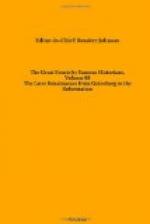Minstrels, instead of books, were in early times the principal medium of communication between authors and the public; they wandered up and down the country, chanting, singing, or reciting, according to the taste of their customers, and had certain privileges of entertainment in the halls of the nobility.
It may be wondered that Caxton, like many of the foreign printers, did not begin with, or at least some time during his career print, the Scriptures, especially as Wycliffe’s translation had already been made. But there were good reasons. Religious persecution ran high, and the clergy were extremely jealous of the propagation of the Scriptures among the people. Knighton had denounced the reading of the Bible, lamenting lest this jewel of the Church, hitherto the exclusive property of the clergy and divines, should be made common to the laity; and Archbishop Arundel had issued an enactment that no part of the Scriptures in English should be read, either in public or private, or be thereafter translated, under pain of the greater excommunication. The Star Chamber, too, was big with terrors. A little later, Erasmus’ edition of the New Testament was forbidden at Cambridge; and in the county of Surrey the Vicar of Croydon said from the pulpit, “We must root out printing, or printing will root out us.”
Winkin de Worde, who had come in his youth with Caxton to England and continued with him in the superintendence of his office to the day of his death, succeeded to the business, and conducted it with great spirit for the next forty years. He began by entirely remodelling his fonts of Gothic type, and introduced both Roman and Italic; became his own founder, instead of importing type from the Low Countries; promoted the manufacture of paper in this country; and such was his activity that he printed the extraordinary number of four hundred eight different works. He deserves, perhaps, more praise than he has ever received for the important part he played in establishing and advancing the art in England.
But no one of our early printers deserves more grateful remembrance than Richard Grafton, who, in 1537, was the first publisher of the Bible in England. I say in England, because the first Bible, known as Coverdale’s, and several editions of the Testament, translated by Tyndale, had been previously printed abroad in secrecy. Grafton’s first edition of the Bible was a reprint of Coverdale and Tyndale’s translation, with slight alterations, by one who assumed the name of Thomas Matthew, but whose real name was John Rogers, then Prebendary of St. Paul’s, and afterward burned as a heretic in Smithfield. Even this was printed secretly abroad, nobody yet knows where, and did not have Grafton’s name attached to it till the King had granted him a license under the privy seal. Though this year, 1537, has by the annalists of the Bible been called the first year of triumph, on account of the King’s license, yet Bibles were still apt to be dangerous things to all concerned; and what was permitted one day was not unlikely, by a change in religion or policy, to be interdicted the next with severe visitations.




